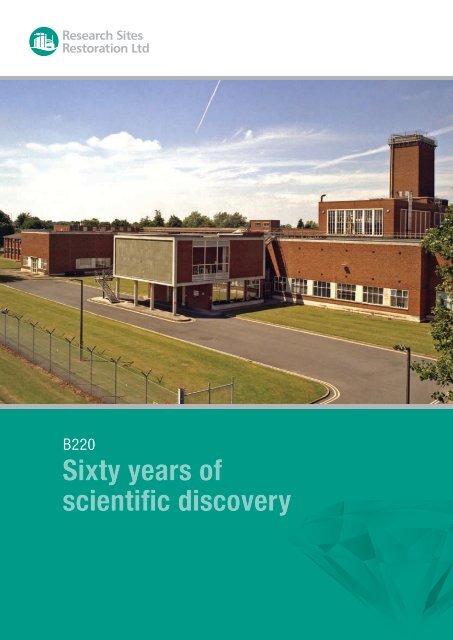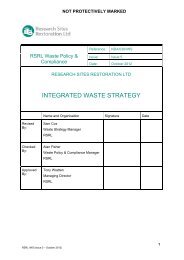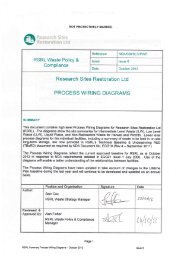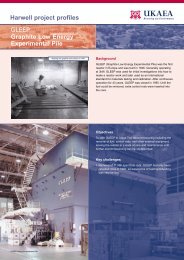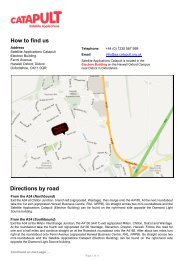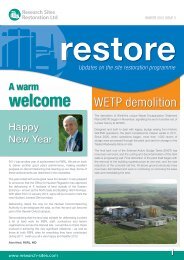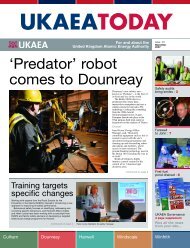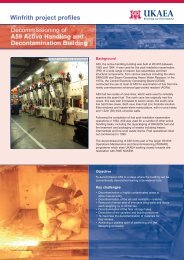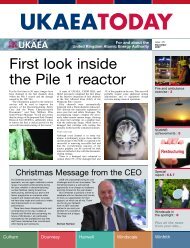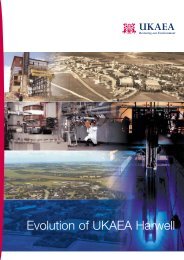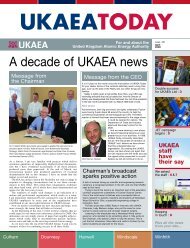B220 - Research Sites Restoration Ltd
B220 - Research Sites Restoration Ltd
B220 - Research Sites Restoration Ltd
- No tags were found...
Create successful ePaper yourself
Turn your PDF publications into a flip-book with our unique Google optimized e-Paper software.
Gaininga wider understandingAs part of the national atomic energy research and development programme,scientists at the Harwell laboratories studied the chemistry of irradiated fuels andactinides – radioactive heavy metals, such as plutonium, protactinium and neptunium.At this time, they in fact led the world in the development of reprocessing techniquesto isolate and purify plutonium from irradiated fuel.Not a naturally occurring element, plutonium is obtainedas a by-product of the irradiation of uranium fuel. Thechemical extraction of plutonium during the reprocessingof irradiated fuel ensured the laboratories had a supply ofthe element for fundamental research into its behaviour.In the 1940s and 1950s, the potential uses for plutoniumwere high profile. So, gaining an understanding of chemicalextraction methods, and the physical and chemicalproperties of both uranium and plutonium oxides andcarbides, was essential for nuclear energy research.Rapidly expanding programmeTo begin with, the scientists’ experiments were on asmall scale but the pace stepped up as larger quantitiesof material became available from reactors at Harwelland Windscale. Before long, the UK’s rapidly expandingnuclear programme required the production of actinideelements in industrial quantities, as well as reactor fuelsfor a variety of prototype reactor types. A demand thatHarwell’s radiochemical laboratories met.To ensure the safety of nuclear reactors, now as then, itis essential to be able to understand how fuels behaveunder extreme conditions. The scientists and engineersof the radiochemical laboratories were at the forefront inthis field, providing much-needed data for the designersof early reactors and of fuel fabrication, enrichment andreprocessing plants.The work of the laboratories expanded throughoutthe 1950s and an extension to the building was soonneeded to provide an additional glove-box hall.Following the construction of the first commercialMagnox reactors, research on the fast reactor fuel cyclebecame an important part of the work. Reactor fuelstudies, originally concerned with metal materials, nowexpanded to cover uranium and plutonium oxides andcarbides. By now, the skill base of the staff had widenedto include physicists, metallurgists and ceramicists tocomplement the chemists.Fabrication PuO 2 in Gloveboxes 1960(U, Pu) O 2 Spherical Fuel ParticlesGlovebox Hall extension early 1950sVacuum Line for Preparation ofActinide Fluorides4 <strong>B220</strong> 60 Anniversary <strong>B220</strong> 60 Anniversary 5
An importantpart of nuclear historyIn parallel to their fundamental research, the laboratories’ scientists have alsocontributed pioneering and seminal work on the treatment and immobilisation ofradioactive wastes, and the chemistry of wastes in underground repository conditions.A new remote-handling facility was opened in 1986.Described as ‘state-of-the-art’, it housed moveablestainless steel containment boxes within heavily shieldedenclosures. The new facility, designed for reprocessingrelatedresearch, also served another function: it providedan ideal and safe environment within which to studysimulated reactor accidents.Modern medical advancesThere have been practical and beneficial spin-offs from theendeavours of the Harwell scientists in the radiochemistrylaboratories.The potential uses of separated isotopes in severalareas, including medical and industrial applications, werequickly recognised. This groundbreaking research, whichhad its origins at Harwell, was developed at a separateRadiochemical Centre, split out from UKAEA in 1971,established at Amersham.Today, medical procedures that use radioisotopes in thediagnosis and treatment of many conditions, notablycancers, have become almost routine. Modern advancesin areas such as radiotherapy and nuclear medicalimaging techniques were influenced by these earlyscientific studies.A testament to scienceToday’s mature nuclear industry no longer requires alarge-scale facility like the radiochemistry laboratories.Since the mid-1990s, a progressive programme ofdecommissioning has been underway. Large areas ofthe building have already been cleared.In the last 15 years, a total of some 350 glove-boxes alonehave been dismantled and removed, including ten hugeand highly active floor-to-ceiling facilities – another exactingchallenge successfully met.Several laboratories have also been decommissioned andmuch of the building is now empty, kept in a state of careand maintenance, awaiting final decommissioning.After sixty years, Harwell’s radiochemistry building standsas a testament to the many fine scientists, engineers andothers who have worked there down the decades, themany benefits their researches have led to – in the nuclearindustry and far beyond – and to the robustness of a trulyunique and innovative design.<strong>B220</strong> GPM05 DecommissioningSuccess 2000<strong>B220</strong>.29 extension 1986 <strong>B220</strong>.29 operationsRemote controlled gloveboxdismantling6 <strong>B220</strong> 60 Anniversary <strong>B220</strong> 60 Anniversary 7
ChemistryAwardOn 25 November 2009 The Royal Society of Chemistryawarded Harwell Laboratory a National ChemicalLandmark Award.For over 60 years Chemistry Division has providedfundamental support in the development of nuclear powerin the UK and a greater understanding of the chemistry ofactinide elements. This provides much needed data forthe designers of the reactors and chemical plants for fuelfabrication, enrichment and reprocessing.The award was made in recognition of this pioneeringresearch and development work.Aerial view of <strong>B220</strong> complexAerial view of Harwell Scienceand Innovation CampusFront view of <strong>B220</strong>Side view of <strong>B220</strong>8 <strong>B220</strong> 60 Anniversary <strong>B220</strong> 60 Anniversary
<strong>Research</strong> <strong>Sites</strong> <strong>Restoration</strong> <strong>Ltd</strong>Harwell Science and Innovation CampusDidcot, Oxon OX11 0DFTel: +44 (0)1235 820220www.research-sites.com


